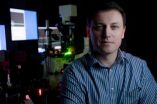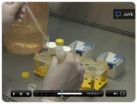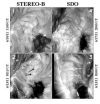(Press-News.org) PHILADELPHIA — Niacin, or vitamin B3, is the one approved drug that elevates "good" cholesterol (high density lipoprotein, HDL) while depressing "bad" cholesterol (low density lipoprotein , LDL), and has thereby attracted much attention from patients and physicians. Niacin keeps fat from breaking down, and so obstructs the availability of LDL building blocks.
Patients often stop taking niacin because it causes uncomfortable facial flushing, an effect caused by the release of a fat called prostaglandin or (PG)D2. PGD2 is the primary cause of the unwanted vasodilation, the "niacin flush." The dilation occurs when blood vessels widen from relaxed smooth muscle cells within vessel walls.
PGD2, formed by an enzyme called COX-2 and released by immune and skin cells, acts on a muscle cell-surface receptor called DP1 to cause the flushing. In fact, a combination of a DP1- blocking drug and niacin is being evaluated in a large clinical trial to determine its effectiveness in reducing heart attacks, as opposed to other drugs that reduce LDL cholesterol.
In work published in the Journal of Clinical Investigation this month, first authors Wenliang Song, MD, research assistant professor, and Jane Stubbe, PhD, postdoctoral fellow, in the Perelman School of Medicine, University of Pennsylvania, and their colleagues now question the wisdom of blocking DP1 in patients prone to cardiovascular disease, especially those taking niacin.
Drawing evidence from studies in mice and humans, they show that platelets -- complicated cells circulating in the bloodstream that stick together in the first phase of blood clotting -- make PGD2, which acts as a brake via DP1 on their own activation. This is surprising as PGD2 is made in platelets by COX-1, the target inhibited by low-dose aspirin.
COX-1 in platelets also makes thromboxane (Tx)A2, another fat that activates platelets. As low-dose aspirin is cardioprotective by thinning blood, the benefit from shutting down platelet TxA2 trumps the potential risk of suppressing platelet PGD2 production.
To gather more information on the potential risks from blocking DP1, the Penn investigators used mice lacking the DP1 receptor. However, unlike humans, mice do not express DP1 in their platelets. "Frankly, because of this, we did not expect to detect any signal of cardiovascular hazard in the mice," notes senior author Garret FitzGerald, MD, director of the Institute for Translational Medicine and Therapeutics.
However, deletion of DP1 made mice somewhat more susceptible to hardening of the arteries, the formation of aneurysm, thrombosis, and in some cases, high blood pressure. The researchers suggest that these findings are reflective of DP1 expression in vascular and immune cells in mice, just as in humans, despite its absence on mouse platelet cells.
Turning back to humans, the Penn investigators discovered that niacin evoked COX-1- dependent formation of both TxA2 and PGD2 in platelets and that a DP1 blockade enhanced the effect of TxA2 on platelet activation.
Taken together, these interwoven findings suggest that blocking the effects of PGD2 on DP1 is likely to be undesirable in patients with heart disease, and perhaps in particular, those taking niacin. That possibility is not addressed by the design of the large ongoing trial of the niacin/DP1 antagonist combination, say the researchers.
Should such a hazard exist, FitzGerald expects it to be confined to those patients not taking low-dose aspirin, along with niacin. "This potential hazard of blocking one aspect of PGD2 action, the one dependent on DP1, contrasts nicely with our recent report that blocking its other receptor, DP2, may be beneficial in limiting male-pattern baldness" said FitzGerald.
###Penn Medicine is one of the world's leading academic medical centers, dedicated to the related missions of medical education, biomedical research, and excellence in patient care. Penn Medicine consists of the Raymond and Ruth Perelman School of Medicine at the University of Pennsylvania (founded in 1765 as the nation's first medical school) and the University of Pennsylvania Health System, which together form a $4.3 billion enterprise.
The Perelman School of Medicine is currently ranked #2 in U.S. News & World Report's survey of research-oriented medical schools. The School is consistently among the nation's top recipients of funding from the National Institutes of Health, with $479.3 million awarded in the 2011 fiscal year.
The University of Pennsylvania Health System's patient care facilities include: The Hospital of the University of Pennsylvania -- recognized as one of the nation's top 10 hospitals by U.S. News & World Report; Penn Presbyterian Medical Center; and Pennsylvania Hospital — the nation's first hospital, founded in 1751. Penn Medicine also includes additional patient care facilities and services throughout the Philadelphia region.
Penn Medicine is committed to improving lives and health through a variety of community-based programs and activities. In fiscal year 2011, Penn Medicine provided $854 million to benefit our community.
Penn study cautions use of drugs to block 'niacin flush'
2012-04-10
ELSE PRESS RELEASES FROM THIS DATE:
23andMe identifies 5 significant genetic associations for hypothyroidism
2012-04-10
MOUNTAIN VIEW, CA – (April 6, 2012) – Using its unique online research platform, 23andMe, a leading personal genetics company, has found five significant genetic associations for hypothyroidism in the largest known genome-wide association study of hypothyroidism conducted to date. The details of the study are now available online in the journal PLoS ONE.
"With nearly 90 percent of our 125,000 customers participating in our online research, 23andMe is making crowd-sourced science a reality," stated 23andMe CEO and co-founder Anne Wojcicki. "Our online research platform ...
Researcher finds faster, cheaper way to cool electronic devices
2012-04-10
A North Carolina State University researcher has developed a more efficient, less expensive way of cooling electronic devices – particularly devices that generate a lot of heat, such as lasers and power devices.
The technique uses a "heat spreader" made of a copper-graphene composite, which is attached to the electronic device using an indium-graphene interface film "Both the copper-graphene and indium-graphene have higher thermal conductivity, allowing the device to cool efficiently," says Dr. Jag Kasichainula, an associate professor of materials science and engineering ...
New poll shows New York voters support global health research but unsure where it is conducted
2012-04-10
WASHINGTON—April 9, 2012— New York voters recognize the importance of global health research and are concerned about the United States' ability to compete globally, according to a new poll commissioned by Research!America, yet an overwhelming majority (93%) of those polled don't know where global health research is conducted in their own state.
The majority of New Yorkers (64%) think that New York residents should be concerned about global health and an additional 63% believe that spending money on global health is important to their state's economy. However, poll results ...
'Nanobubbles' plus chemotherapy equals single-cell cancer targeting
2012-04-10
HOUSTON -- (April 9, 2012) -- Using light-harvesting nanoparticles to convert laser energy into "plasmonic nanobubbles," researchers at Rice University, the University of Texas MD Anderson Cancer Center and Baylor College of Medicine (BCM) are developing new methods to inject drugs and genetic payloads directly into cancer cells. In tests on drug-resistant cancer cells, the researchers found that delivering chemotherapy drugs with nanobubbles was up to 30 times more deadly to cancer cells than traditional drug treatment and required less than one-tenth the clinical dose.
"We ...
Researchers identify genes that may help in ovarian cancer diagnosis and prognosis
2012-04-10
Philadelphia, PA, April 9, 2012 – Scientists from Duke University Medical Center have determined that genes acting as molecular "on/off" switches can define clinically relevant molecular subtypes of ovarian cancer, providing ideal potential targets for use in clinical prognostic and diagnostic testing. These bimodal genes can define tumor subtypes that have different overall prognoses and respond to different therapeutic regimens. The researchers' results are published in the May issue of The Journal of Molecular Diagnostics.
"We identified a very small set of genes ...
A better tool to diagnose tuberculosis
2012-04-10
Up to 30% of the world's population is infected with Tuberculosis (TB), but in many areas of the world, TB diagnosis still relies on insensitive, poorly standardized, and time-consuming methods. A new diagnostic tool, endorsed by the World Health Organization (WHO), may change that. Dr. Thomas Bodmer shows how it's done in the Journal of Visualized Experiments (JoVE).
Currently, TB is diagnosed through either a skin test, which produces a small bump on the patient's arm when administered and needs to be checked after 72 hours, and through smear microscopy, a method that ...
WirelessTimeClock.com Launches Redesigned Site
2012-04-10
WirelessTimeClock.com, a trusted source for web-based time clocks, has re-launched its website (http://www.wirelesstimeclock.com) with a more intuitive and streamlined design, promising a more enriching experience for businesses searching for reliable employee time clocks and time and attendance management solutions.
"Our customers have been asking for a more intuitive, resourceful site," says Scott Tobin, owner of WirelessTimeClock.com. "We wanted to make sure they could find exactly the clocks and monthly plans that would fit their business needs."
With ...
High-resolution atomic imaging of specimens in liquid by TEM using graphene liquid cell
2012-04-10
Daejeon, the Republic of Korea, April 9, 2012—The Korea Advanced Institute of Science and Technology (KAIST) announced that a research team from the Department of Materials Science and Engineering has developed a technology that enables scientists and engineers to observe processes occurring in liquid media on the smallest possible scale which is less than a nanometer.
Professor Jeong Yong Lee and Researcher Jong Min Yuk, in collaboration with Professor Paul Alivisatos's and Professor Alex Zettl's groups at the University of California, Berkeley, succeeded in making ...
Normalizing tumor blood vessels improves delivery of only the smallest nanomedicines
2012-04-10
Combining two strategies designed to improve the results of cancer treatment – antiangiogenesis drugs and nanomedicines – may only be successful if the smallest nanomedicines are used. A new study from Massachusetts General Hospital (MGH) researchers, appearing in Nature Nanotechnology, finds that normalizing blood vessels within tumors, which improves the delivery of standard chemotherapy drugs, can block the delivery of larger nanotherapy molecules.
"We found that vascular normalization only increases the delivery of the smallest nanomedicines to cancer cells," says ...
SDO and STEREO spot something new on the sun
2012-04-10
One day in the fall of 2011, Neil Sheeley, a solar scientist at the Naval Research Laboratory in Washington, D.C., did what he always does – look through the daily images of the sun from NASA's Solar Dynamics Observatory (SDO).
But on this day he saw something he'd never noticed before: a pattern of cells with bright centers and dark boundaries occurring in the sun's atmosphere, the corona. These cells looked somewhat like a cell pattern that occurs on the sun's surface -- similar to the bubbles that rise to the top of boiling water -- but it was a surprise to find this ...




